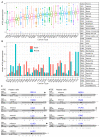CD73, Tumor Plasticity and Immune Evasion in Solid Cancers
- PMID: 33430239
- PMCID: PMC7825701
- DOI: 10.3390/cancers13020177
CD73, Tumor Plasticity and Immune Evasion in Solid Cancers
Abstract
Regulatory networks controlling cellular plasticity, important during early development, can re-emerge after tissue injury and premalignant transformation. One such regulatory molecule is the cell surface ectoenzyme ecto-5'-nucleotidase that hydrolyzes the conversion of extracellular adenosine monophosphate to adenosine (eADO). Ecto-5'-nucleotidase (NT5E) or cluster of differentiation 73 (CD73), is an enzyme that is encoded by NT5E in humans. In normal tissue, CD73-mediated generation of eADO has important pleiotropic functions ranging from the promotion of cell growth and survival, to potent immunosuppression mediated through purinergic G protein-coupled adenosine receptors. Importantly, tumors also utilize several mechanisms mediated by CD73 to resist therapeutics and in particular, evade the host immune system, leading to undesired resistance to targeted therapy and immunotherapy. Tumor cell CD73 upregulation is associated with worse clinical outcomes in a variety of cancers. Emerging evidence indicates a link between tumor cell stemness with a limited host anti-tumor immune response. In this review, we provide an overview of a growing body of evidence supporting the pro-tumorigenic role of CD73 and adenosine signaling. We also discuss data that support a link between CD73 expression and tumor plasticity, contributing to dissemination as well as treatment resistance. Collectively, targeting CD73 may represent a novel treatment approach for solid cancers.
Keywords: CD73; cancer stemness; drug repurposing; immunotherapy; metastasis; targeted therapy; treatment resistance; tumor differentiation; tumor plasticity.
Conflict of interest statement
The authors declare no conflict of interest.
Figures





Similar articles
-
Cell type- and tissue-specific functions of ecto-5'-nucleotidase (CD73).Am J Physiol Cell Physiol. 2019 Dec 1;317(6):C1079-C1092. doi: 10.1152/ajpcell.00285.2019. Epub 2019 Aug 28. Am J Physiol Cell Physiol. 2019. PMID: 31461341 Free PMC article. Review.
-
Dual role of CD73 as a signaling molecule and adenosine-generating enzyme in colorectal cancer progression and immune evasion.Int J Biol Sci. 2024 Jan 1;20(1):137-151. doi: 10.7150/ijbs.87440. eCollection 2024. Int J Biol Sci. 2024. PMID: 38164172 Free PMC article.
-
Methotrexate up-regulates ecto-5'-nucleotidase/CD73 and reduces the frequency of T lymphocytes in the glioblastoma microenvironment.Purinergic Signal. 2016 Jun;12(2):303-12. doi: 10.1007/s11302-016-9505-8. Epub 2016 Feb 24. Purinergic Signal. 2016. PMID: 26910734 Free PMC article.
-
CD73 as a potential opportunity for cancer immunotherapy.Expert Opin Ther Targets. 2019 Feb;23(2):127-142. doi: 10.1080/14728222.2019.1559829. Epub 2018 Dec 26. Expert Opin Ther Targets. 2019. PMID: 30556751 Review.
-
Targeting CD73 to augment cancer immunotherapy.Curr Opin Pharmacol. 2020 Aug;53:66-76. doi: 10.1016/j.coph.2020.07.001. Epub 2020 Aug 7. Curr Opin Pharmacol. 2020. PMID: 32777746 Free PMC article. Review.
Cited by
-
Mesothelioma Malignancy and the Microenvironment: Molecular Mechanisms.Cancers (Basel). 2021 Nov 12;13(22):5664. doi: 10.3390/cancers13225664. Cancers (Basel). 2021. PMID: 34830817 Free PMC article. Review.
-
CD73 Severed as a Potential Prognostic Marker and Promote Lung Cancer Cells Migration via Enhancing EMT Progression.Front Genet. 2021 Nov 17;12:728200. doi: 10.3389/fgene.2021.728200. eCollection 2021. Front Genet. 2021. PMID: 34868205 Free PMC article.
-
Evidence that cervical cancer cells cultured as tumorspheres maintain high CD73 expression and increase their protumor characteristics through TGF-β production.Cell Biochem Funct. 2022 Oct;40(7):760-772. doi: 10.1002/cbf.3742. Epub 2022 Sep 7. Cell Biochem Funct. 2022. PMID: 36070413 Free PMC article.
-
CD73 is a hypoxia-responsive gene and promotes the Warburg effect of human gastric cancer cells dependent on its enzyme activity.J Cancer. 2021 Sep 3;12(21):6372-6382. doi: 10.7150/jca.62387. eCollection 2021. J Cancer. 2021. PMID: 34659527 Free PMC article.
-
Purines and purinergic receptors in primary tumors of the central nervous system.Purinergic Signal. 2025 Jun;21(3):429-446. doi: 10.1007/s11302-024-10053-8. Epub 2024 Oct 1. Purinergic Signal. 2025. PMID: 39352574 Free PMC article.
References
-
- Yuan S., Norgard R.J., Stanger B.Z. Cellular Plasticity in Cancer. Cancer Discov. 2019;9:837–851. doi: 10.1158/2159-8290.CD-19-0015. - DOI - PMC - PubMed
Publication types
LinkOut - more resources
Full Text Sources
Other Literature Sources
Research Materials
Miscellaneous

